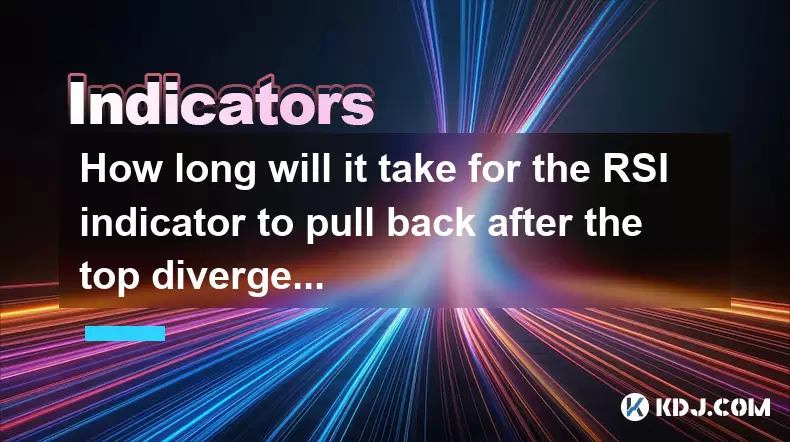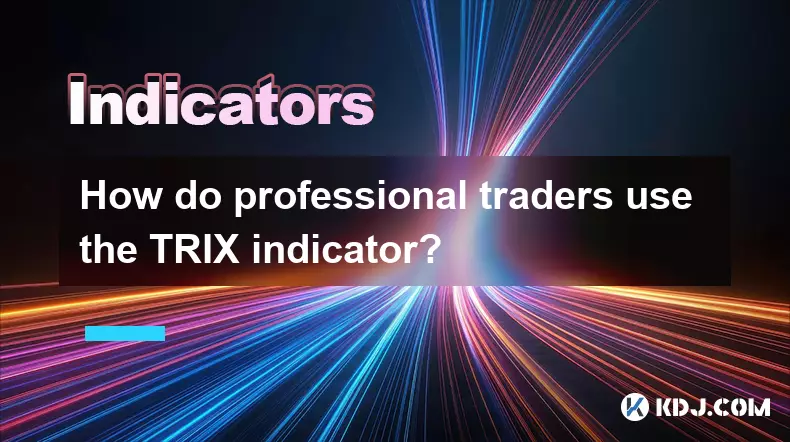-
 bitcoin
bitcoin $102182.982207 USD
-0.92% -
 ethereum
ethereum $3438.744518 USD
0.12% -
 tether
tether $0.999933 USD
0.02% -
 xrp
xrp $2.405093 USD
0.05% -
 bnb
bnb $956.306114 USD
-0.53% -
 solana
solana $153.028851 USD
-1.23% -
 usd-coin
usd-coin $0.999800 USD
-0.03% -
 tron
tron $0.294898 USD
-1.08% -
 dogecoin
dogecoin $0.171428 USD
-0.58% -
 cardano
cardano $0.551186 USD
-1.15% -
 hyperliquid
hyperliquid $38.755878 USD
0.04% -
 chainlink
chainlink $15.298460 USD
-0.05% -
 bitcoin-cash
bitcoin-cash $516.067428 USD
1.68% -
 stellar
stellar $0.280726 USD
-0.42% -
 zcash
zcash $518.919369 USD
18.01%
How long will it take for the RSI indicator to pull back after the top divergence?
RSI top divergence in crypto trading signals weakening bullish momentum, often leading to a pullback within hours or days, depending on market conditions and timeframe analyzed.
Jun 19, 2025 at 04:49 am

Understanding RSI Top Divergence in Cryptocurrency Trading
The Relative Strength Index (RSI) is one of the most widely used technical indicators among cryptocurrency traders. It helps identify overbought or oversold conditions, as well as potential reversal points through divergences. Top divergence occurs when the price makes a new high, but the RSI fails to confirm this by making a lower high. This often signals that bullish momentum is weakening and a potential pullback may be imminent.
In the context of cryptocurrency trading, where volatility is significantly higher compared to traditional markets, understanding how long it takes for the RSI to pull back after top divergence becomes crucial. Traders often seek to time entries or exits based on these signals, especially during sharp rallies followed by sudden corrections.
Factors Influencing the Timeframe of an RSI Pullback
Several factors affect how quickly the RSI pulls back after forming a top divergence:
- Market Sentiment: In crypto, sentiment can shift rapidly due to news, regulatory updates, or macroeconomic events. If negative sentiment follows a top divergence, the RSI may pull back within hours.
- Trading Volume: A sudden drop in volume after a rally often accelerates the RSI correction, sometimes leading to a pullback within minutes or a few candlesticks.
- Timeframe Analyzed: On shorter timeframes like 15-minute or 1-hour charts, RSI pullbacks tend to occur more quickly than on daily or weekly charts. For instance, a top divergence on a 1-hour chart might see the RSI drop below 70 within 4 to 8 hours.
- Strength of Divergence: The more pronounced the divergence between price action and RSI, the quicker the indicator tends to correct itself.
Each of these elements plays a role in determining how soon the RSI will react after a top divergence forms.
Analyzing Historical Data for RSI Behavior Post-Divergence
To estimate how long it typically takes for the RSI to pull back after top divergence, historical data from major cryptocurrencies like Bitcoin (BTC) and Ethereum (ETH) can provide useful insights. By examining multiple instances across different market cycles, we observe recurring patterns:
- During strong uptrends, the RSI may remain above 70 for extended periods before pulling back, even with top divergence present.
- In choppy or sideways markets, the RSI often reverts below 70 within 6 to 12 candlesticks on the 1-hour chart.
- After significant resistance breakouts followed by rejection, the RSI can fall below 70 within 2 to 4 candlesticks on the 4-hour timeframe.
For example, during Bitcoin's late 2023 rally, there were several occasions where top divergence formed on the 4-hour chart. In those cases, the RSI pulled back below 70 within approximately 12 to 24 hours after the divergence was confirmed.
How to Confirm RSI Top Divergence Before Expecting a Pullback
Before anticipating a pullback in the RSI, it’s essential to ensure that the divergence is valid. Here are the steps to confirm RSI top divergence:
- Identify at least two swing highs on the price chart where the second high is higher than the first.
- Check the corresponding RSI values for those highs; the second RSI peak should be lower than the first.
- Ensure both peaks are clearly defined and not overlapping with other price structures.
- Use additional tools like moving averages or volume analysis to strengthen the validity of the divergence signal.
Once confirmed, traders can begin monitoring how long it takes for the RSI to return to neutral territory (typically below 70). In many cases, this happens within a few candlesticks, especially if bearish pressure begins to build.
Monitoring RSI Behavior Across Multiple Timeframes
A key strategy among experienced crypto traders involves analyzing RSI behavior across multiple timeframes simultaneously. For example:
- A top divergence seen on the 1-hour chart may not yet appear on the 4-hour chart, indicating that the pullback may take longer.
- Conversely, if top divergence appears on both the 1-hour and 4-hour charts, the likelihood of a faster RSI pullback increases significantly.
Traders should also pay attention to support levels coinciding with the expected pullback zone. If the price approaches a critical support level while the RSI is still elevated, the pullback may accelerate once that support is tested.
Another technique is to overlay Bollinger Bands or MACD to cross-verify the strength of the move. When the RSI starts to decline and MACD lines cross bearishly, it reinforces the expectation of a near-term pullback.
FAQs About RSI Pullbacks After Top Divergence
Q: Can RSI stay overbought for a long time without pulling back after top divergence?Yes, especially during strong bullish trends. In such cases, the RSI may remain above 70 for several candlesticks even after a top divergence forms. This doesn't invalidate the signal but suggests that the trend has enough momentum to resist immediate correction.
Q: Should I short immediately after identifying a top divergence?Not necessarily. While top divergence indicates weakening momentum, it does not guarantee an immediate reversal. It’s advisable to wait for confirmation such as a bearish candlestick pattern, a break of a trendline, or a drop in volume before initiating a trade.
Q: Does the RSI behave differently on various cryptocurrencies?Yes, altcoins often exhibit more erratic RSI behavior compared to major coins like BTC or ETH. Lower liquidity and higher volatility can cause the RSI to spike and correct more sharply, which affects the timing of pullbacks.
Q: Is it reliable to use RSI alone for predicting pullbacks?Relying solely on RSI can lead to false signals. Combining it with other tools like Fibonacci retracement, support/resistance levels, or volume indicators enhances its reliability and improves decision-making accuracy.
Disclaimer:info@kdj.com
The information provided is not trading advice. kdj.com does not assume any responsibility for any investments made based on the information provided in this article. Cryptocurrencies are highly volatile and it is highly recommended that you invest with caution after thorough research!
If you believe that the content used on this website infringes your copyright, please contact us immediately (info@kdj.com) and we will delete it promptly.
- Altcoin Summer Heats Up: Token Burns and Major Updates Take Center Stage
- 2025-11-14 06:40:00
- Airdrop Anarchy: Unmasking Manipulation in the Crypto Wild West
- 2025-11-14 04:55:01
- BlockDAG, Airdrop Mania, and 2025: What's the Hype?
- 2025-11-14 05:15:01
- Michael Saylor, MSTR, and the Undervaluation Debate: A New York Perspective
- 2025-11-14 05:50:01
- dYdX, Buyback Program, and Community: A New Era for DeFi?
- 2025-11-14 04:50:01
- Avalanche, Liquid Yield, and Dynamic Rebalancing: A New Era for DeFi?
- 2025-11-14 05:30:01
Related knowledge

What's the best way to learn the TRIX indicator?
Nov 10,2025 at 12:39pm
Understanding the Basics of the TRIX Indicator1. The TRIX (Triple Exponential Average) indicator is a momentum oscillator designed to filter out short...

How do professional traders use the TRIX indicator?
Nov 06,2025 at 04:40pm
Understanding the TRIX Indicator in Crypto TradingThe TRIX (Triple Exponential Average) indicator is a momentum oscillator used by professional trader...

Can I use the TRIX indicator on my mobile trading app?
Nov 07,2025 at 07:40pm
The TRIX indicator, a momentum oscillator designed to filter out short-term fluctuations and highlight long-term trends, has become increasingly popul...

How to use the TRIX indicator in a sideways market?
Nov 10,2025 at 03:00pm
Bitcoin’s Role in Decentralized Finance Evolution1. Bitcoin remains the cornerstone of decentralized finance, serving as both a store of value and a b...

How does volume affect the signals from the TRIX indicator?
Nov 13,2025 at 07:39am
Understanding the TRIX Indicator in Cryptocurrency TradingThe TRIX (Triple Exponential Average) indicator is a momentum oscillator designed to filter ...

How to code a simple TRIX indicator script in Pine Script?
Nov 07,2025 at 06:20am
How to Code a Simple TRIX Indicator in Pine Script The TRIX (Triple Exponential Moving Average) indicator is widely used in cryptocurrency trading to ...

What's the best way to learn the TRIX indicator?
Nov 10,2025 at 12:39pm
Understanding the Basics of the TRIX Indicator1. The TRIX (Triple Exponential Average) indicator is a momentum oscillator designed to filter out short...

How do professional traders use the TRIX indicator?
Nov 06,2025 at 04:40pm
Understanding the TRIX Indicator in Crypto TradingThe TRIX (Triple Exponential Average) indicator is a momentum oscillator used by professional trader...

Can I use the TRIX indicator on my mobile trading app?
Nov 07,2025 at 07:40pm
The TRIX indicator, a momentum oscillator designed to filter out short-term fluctuations and highlight long-term trends, has become increasingly popul...

How to use the TRIX indicator in a sideways market?
Nov 10,2025 at 03:00pm
Bitcoin’s Role in Decentralized Finance Evolution1. Bitcoin remains the cornerstone of decentralized finance, serving as both a store of value and a b...

How does volume affect the signals from the TRIX indicator?
Nov 13,2025 at 07:39am
Understanding the TRIX Indicator in Cryptocurrency TradingThe TRIX (Triple Exponential Average) indicator is a momentum oscillator designed to filter ...

How to code a simple TRIX indicator script in Pine Script?
Nov 07,2025 at 06:20am
How to Code a Simple TRIX Indicator in Pine Script The TRIX (Triple Exponential Moving Average) indicator is widely used in cryptocurrency trading to ...
See all articles










































































